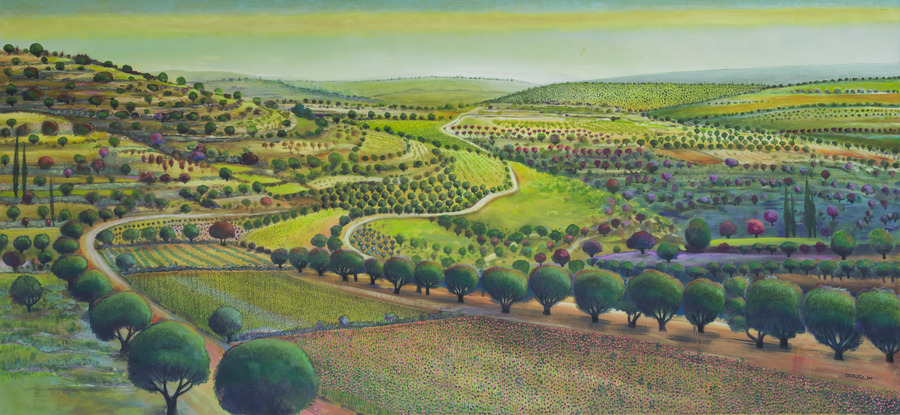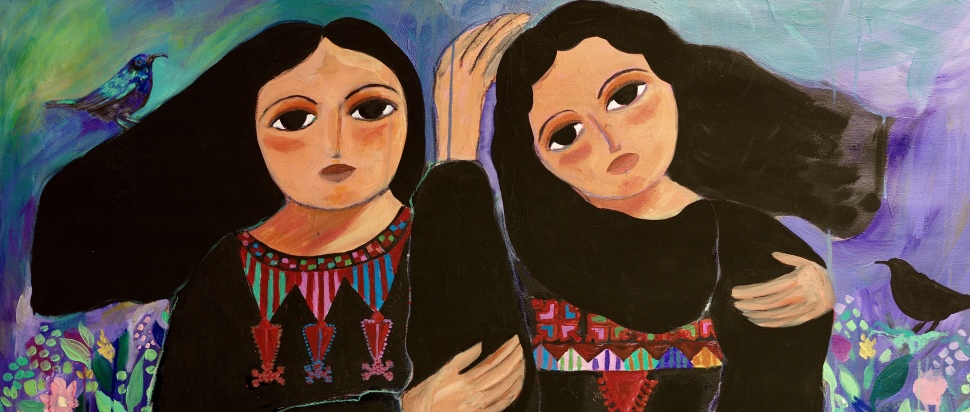Palestine Museum Scotland, Edinburgh
A permanent space for Palestinian art and stories in Edinburgh's New Town explores themes of resistance and perseverance in the face of brutality
Europe’s first museum of contemporary Palestinian art recently opened in Edinburgh. The Palestine Museum Scotland stands on Dundas Street, famous for high-value Scottish contemporary art. Even before you enter, the building intervenes on the quiet, white box gallery street, with colourful and richly textured paintings of Palestinian women living and working in community screened on large windows. It’s a new perspective on display in our capital, a remix of traditional mediums like acrylic, oils and linen to try and distil what it means to create and be shown as people living under siege.
Just before I enter, I encounter a group who had travelled from Amsterdam to see the creative defiance of genocidal violence that we have been watching on our phone screens. Immediately, I find myself grounded in historic Palestine. That is, a map printed to fill half the floor, etching the borders of Palestine pre-Nakba. Over the map, coloured icons show the impact of violence on the landscape. Refugee camps, sites of massacres, depopulated villages and shifting armistice lines are marked out as if they are a warning to us, while we traverse the land. The only historical constant is the mountains, segregated as demilitarised zones, as the dense history, sediments and memory they possess make them inhospitable to colonisation.
There is so much to learn from the way the landscape is portrayed in the museum. Swathes of farms and water, exalted in acrylic, invoke what lies at the heart of Palestinian culture, the stewardship of land. Nabil Anani’s In Pursuit of Utopia gives a colourful, dreamlike depiction of nature undisturbed and left to flourish. Trees age from garden green to autumnal red. With a wall all to itself, you could find yourself lost in the peace of the picture, and take the question, 'what does the Earth have to teach us, if we were to just watch' with you for the rest of the exhibition.

In Pursuit of Utopia by Nabil Anani. Photo courtesy Ziad Anani, Zawyeh Gallery
What we hold and can afford to let go of is a theme carried on to the left side of the first room. Sana Farah Bishara’s bronze sculpture, Woman In All Her Moods, removes the woman’s abdomen leaving only her head, shoulders, arms and long pointed legs. It’s as if the emotion she has been made to carry has dispersed across the room and becomes part of the air we breathe in and the space we take up. In observing her, standing in historic Palestine and entering this museum, we have each committed to becoming a witness and carrying these experiences, in any small form.
Above me, I see parcels wrapped in keffiyehs, suspended from the ceiling with barbed wire. Ibrahim Alazza’s installation All That Remains quietly hovers above the work, a reminder of the resistance and need from which this building has been launched. He gives a stark reminder that these works show life amongst scarce aid and solidarity passed over borders worldwide. The wire causes me to question: where is the solidarity landing, and how can art-making circumvent the violence of occupation?
Under occupation, creativity perseveres. Maisara Baroud quietly protests I Am Still Alive with his black and white paintings, one made for every day he survives in Gaza. Meanwhile, Leena Nammari exposes the hypocrisy of biblical scripture used to justify occupation. With her family members, she created Biblical Jenga, olive wood and brass pieces from Bethlehem, laser engraved with curses inspired by 'the land of the Biblical angry god.' The artist invites learners to do what they will with this new vocabulary and 'learn your curses well.'
There are prints of selected works for sale in the final part of the exhibition, ranging from £35-50. An offering to take a small part of the space home with you fits well with the pared-back ending of the exhibition. This room features smaller works, with a wider range of artists, most of whom have modestly presented their work on paper. The quick flashes of Palestinian life, culture, and belonging are reminiscent of contemporary practice and resistance efforts still in motion.
Just before leaving, I sat with Nameer Qassim’s Enough, a large acrylic painting on canvas. Qassim mosaics the face of a woman from multiple squares of colour. She wears a patterned headband and reaches her arms above her head, crossed at the wrists. The textures of the acrylic are palpable, inviting you closer and closer into the sediment of the image. The history and movements that have informed our recognition of her resistance are as innumerable as the squares in front of you. We’ve played a small, residual part in naming and seeking answers to the contemporary moment. In this exhibition, we trace the steps leading up to and after suppression.
Palestine Museum Edinburgh, 13A Dundas St; Wed-Sun, 11am-6pm
palestinemuseum.us
